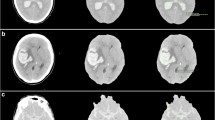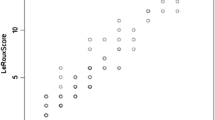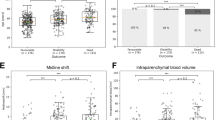Abstract
Background
Intraventricular hemorrhage (IVH) in patients suffering from aneurysmal subarachnoid hemorrhage (aSAH) is a known negative predictor. Scoring systems like Fisher, Le Roux, and original Graeb score (oGS) are established to quantify the volume of IVH. The aim of this study was to evaluate the validity of the recently introduced modified Graeb score (mGS) in patients with aSAH.
Methods
A retrospective analysis of the validity of the oGS and mGS in 257 aSAH patients was performed to assess and compare the predictive value of hospital mortality, development of CHC, and early functional outcome.
Results
In univariate analysis, an increase in either the oGS or mGS was associated with a higher risk for hospital mortality, development of CHC, and poor early functional outcome. The correlation of the oGS and mGS was excellent using Pearson’s product–moment (r = 0.918; p < 0.001). The predictive value of the oGS was superior to the predictive value of the mGS using receiver operating characteristics and corresponding area under the curve value as there was no statistical significant differences between the scores.
Conclusions
Our study confirms the validity of the recently introduced mGS to quantify the volume of IVH and extends its value in aSAH. However, the mGS offers no additional predictive value for hospital mortality, development of CHC, and poor early functional outcome in patients with aSAH patients compared to the less complex oGS.




Similar content being viewed by others
References
Ali M, Bath P, Brady M, Davis S, Diener HC, Donnan G, Fisher M, Hacke W, Hanley DF, Luby M, Tsivgoulis G, Wahlgren N, Warach S, Lees KR, VISTA Steering Committees (2012) Development, expansion, and use of a stroke clinical trials resource for novel exploratory analyses. Int J Stroke 7:133–138
Bardera A, Boada I, Feixas M, Remollo S, Blasco G, Silva Y, Pedraza S (2009) Semiautomated method for brain hematoma and edema quantification using computed tomography. Comput Med Imaging Graph 33:304–311
Czorlich P, Ricklefs F, Reitz M, Vettorazzi E, Abboud T, Regelsberger J, Westphal M, Schmidt NO (2015) Impact of intraventricular hemorrhage measured by Graeb and LeRoux score on case fatality risk and chronic hydrocephalus in aneurysmal subarachnoid hemorrhage. Acta Neurochir 157:409–415
Erixon HO, Sorteberg A, Sorteberg W, Eide PK (2014) Predictors of shunt dependency after aneurysmal subarachnoid hemorrhage: results of a single-center clinical trial. Acta Neurochir 156:2059–2069
Fisher CM, Kistler JP, Davis JM (1980) Relation of cerebral vasospasm to subarachnoid hemorrhage visualized by computerized tomographic scanning. Neurosurgery 6:1–9
Gerner ST, Kuramatsu JB, Abel H, Kloska SP, Lücking H, Eyüpoglu IY, Doerfler A, Schwab S, Huttner HB (2014) Intraventricular fibrinolysis has no effects on shunt dependency and functional outcome in endovascular-treated aneurysmal SAH. Neurocrit Care 21:435–443
DA Graeb RW, Lapointe JA, Neugent RA, Harrison PB (1982) Computed tomographic diagnosis of intraventricular hemorrhage. Etiology and prognosis. Radiology 143:91–96
Hinson HE, Hanley DF, Ziai WC (2010) Management of intraventricular hemorrhage. Curr Neurol Neurosci Rep 10:73–82
Iwaasa M, Ueba T, Nonaka M, Okawa M, Abe H, Higashi T, Inoue T (2013) Safety and feasibility of combined coiling and neuroendoscopy for better outcomes in the treatment of severe subarachnoid hemorrhage accompanied by massive intraventricular hemorrhage. J Clin Neurosci 20:1264–1268
Jaja BN, Cusimano MD, Etminan N, Hanggi D, Hasan D, Ilodigwe D, Lantigua H, Le Roux P, Lo B, Louffat-Olivares A, Mayer S, Molyneux A, Quinn A, Schweizer TA, Schenk T, Spears J, Todd M, Torner J, Vergouwen MD, Wong GK, Singh J, Macdonald RL (2013) Clinical prediction models for aneurysmal subarachnoid hemorrhage: a systemic review. Neurocrit Care 18:143–153
Jennett B, Bond M (1975) Assessment of outcome after severe brain damage. Lancet 1:480–484
Kramer AH, Mikolaenko I, Deis N, Dumont AS, Kassell NF, Bleck TP, Nathan BA (2010) Intraventricular hemorrhage volume predicts poor outcomes but not delayed ischemic neurological deficits among patients with ruptured cerebral aneurysms. Neurosurgery 67:1044–1052, discussion 1052–1053
Kramer AH, Roberts DJ, Holodinsky J, Todd S, Hill MD, Zygun DA, Faris P, Wong JH (2014) Intraventricular tissue plasminogen activator in subarachnoid hemorrhage patients: a prospective, randomized, placebo-controlled pilot-trial. Neurocrit Care 21:275–284
LeRoux PD, Haglund MM, Newell DW, Grady MS, Winn HR (1992) Intraventricular hemorrhage in blunt head trauma: an analysis of 43 cases. Neurosurgery 31:678–685
Lovelock CE, Rinkel GJ, Rothwell PM (2010) Time trends in outcome of subarachnoid hemorrhage: population-based study and systematic review. Neurology 11:1494–1501
Mayfrank L, Hütter B, Kohorst Y, Kreitschmann-Andermahr I, Rohde V, Thron A, Gilsbach J (2001) Influence of intraventricular hemorrhage on outcome after rupture of intracranial aneurysm. Neurosurg Rev 24:185–191
Morgan TC, Dawson J, Spengler D, Lees KR, Aldrich C, Mishra NK, Lane K, Quinn TJ, Diener-West M, Weir CJ, Higgins P, Rafferty M, Kinsley K, Ziai W, Awad I, Walters MR, Hanley D, CLEAR and VISTA Investigators (2013) The modified Graeb score: an enhanced tool for intraventricular hemorrhage and prediction of functional outcome. Stroke 44:645–641
Nieuwkamp DJ, Setz LE, Algra A, Linn FHH, de Rooij NK, Rinkel GJE (2009) Changes in case fatality of aneurysmal subarachnoid haemorrhage over time, according to age, sex, and region: a meta-analysis. Lancet Neurol 8:635–642
Rinkel GJ, Algra A (2011) Long-term outcomes of patients with aneurysmal subarachnoid haemorrhage. Lancet Neurol 10:349–356
Varelas P, Helms A, Sinson G, Spanaki M, Hacein-Bey L (2006) Clipping or coiling of ruptured cerebral aneurysms and shunt-dependent hydrocephalus. Neurocrit Care 4:223–228
Vergouwen MD (2010) Vasospasm versus delayed cerebral ischemia as an outcome event in clinical trials and observational studies. Neurocrit Care 15:308–311
Wilson TJ, Stetler WR Jr, Davis MC, Giles DA, Khan A, Chaudhary N (2015) Intraventricular hemorrhage is associated with early hydrocephalus, symptomatic vasospasm, and poor outcome in aneurysmal subarachnoid hemorrhage. J Neurol Surg A Cent Eur Neurosurg 76:126–132
Woernle CM, Winkler KML, Burkhardt J-K, Haile SR, Bellut D, Neidert MC, Bozinov O, Krayenbühl N, Bernays RL (2013) Hydrocephalus in 389 patients with aneurysm-associated subarachnoid hemorrhage. J Clin Neurosci 20:824–826
Ziai WC, Tuhrim S, Lane K, McBee N, Lees K, Dawson J, Butcher K, Vespa P, Wright DW, Keyl PM, Mendelow AD, Kase C, Wijman C, Lapointe M, John S, Thompson R, Thompson C, Mayo S, Reilly P, Janis S, Awad I, Hanley DF, Investigators CLEARIII (2014) A multicenter, randomized, double-blinded, placebo-controlled phase III study of Clot lysis Evaluation of Accelerated Resolution of Intraventricular Hemorrhage (CLEAR III). Int J Stroke 9:536–542
Conflict of interest
All authors declare that they have no financial or other conflicts of interest in relation to this study and its publication.
Author information
Authors and Affiliations
Corresponding author
Additional information
Comment
Authors Czorlich et al. presented a study on comparison of two scores of intraventricular blood extension after SAH. The Graeb and modified Graeb scores (mGS) were compared, showing no major difference in prediction of mortality, severe morbidity, and shunt dependence after aneurysmal SAH. The study is based on retrospective observation of 257 patients. The methodology is clear and the results are sound. As the authors stated in their paper, external validation of recently proposed mGS is necessary due to the fact that this score is already used in clinical trials enrolling SAH patients. Studied mGS gives very detailed information about blood distribution after SAH and therefore probably has its place in academic studies. On the other hand, computation of mGS is a difficult and time-consuming procedure, which hardly finds its place in routine clinical practice, especially when its prognostic value is similar to the Graeb score, which was examined in the author’s previous paper published in Acta Neurochirurgica. Furthermore, generally accepted is the Fisher scoring system, which is perfectly suitable for routine clinical practice.
Vladimir Benes
Prague, Czech Republic
Czorlich et al. have written a report on two evaluation scores for intraventricular hemorrhage in SAH patients. In their analysis, the researchers found no statistically significant differences between the original and modified Graeb scores. The compared scores have currently little clinical significance, but research literature needs tools for comparing the extent of intraventricular hemorrhage in SAH and ICH patients. However, some attempts at developing new tools lead to more laborious methods with results equaling with the established ones.
The researchers have gathered a retrospective single-institution cohort of 150 patients with intraventricular hemorrhage during the last 5 years. It is advisable, but often quite difficult, to evaluate clinical scores in a prospective setting. Aside of this fundamental shortcoming, the paper is well constructed and the results are credible. The scores seem to perform equally well or badly in prognosticating mortality, development of chronic hydrocephalus, or bad clinical outcome.
The original Graeb score is easier and more efficient in clinical and research-related use. Adding complexity in prognostic models seldom increases their usability, and cumbersome tools may reduce the amount of recruited patients in prognostic research projects.
Mika Niemla
Helsinki, Finland
Rights and permissions
About this article
Cite this article
Czorlich, P., Mende, K.C., Vettorazzi, E. et al. Validation of the modified Graeb score in aneurysmal subarachnoid hemorrhage. Acta Neurochir 157, 1867–1872 (2015). https://doi.org/10.1007/s00701-015-2583-5
Received:
Accepted:
Published:
Issue Date:
DOI: https://doi.org/10.1007/s00701-015-2583-5




